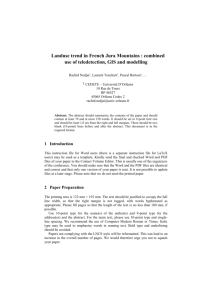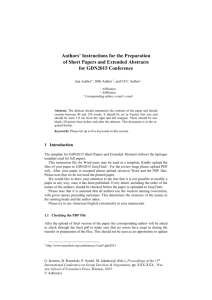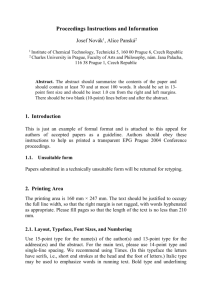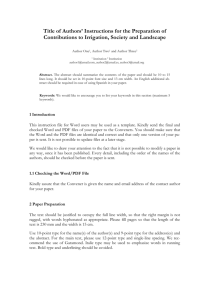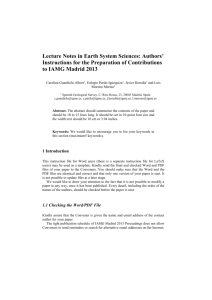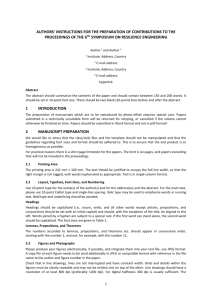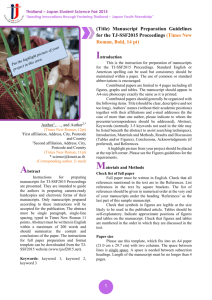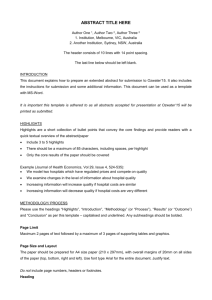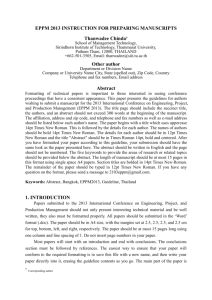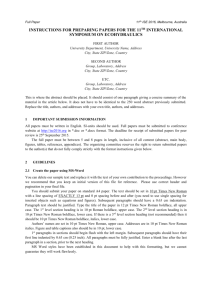Nuclear and Emerging Technologies for Space in Today`s Society
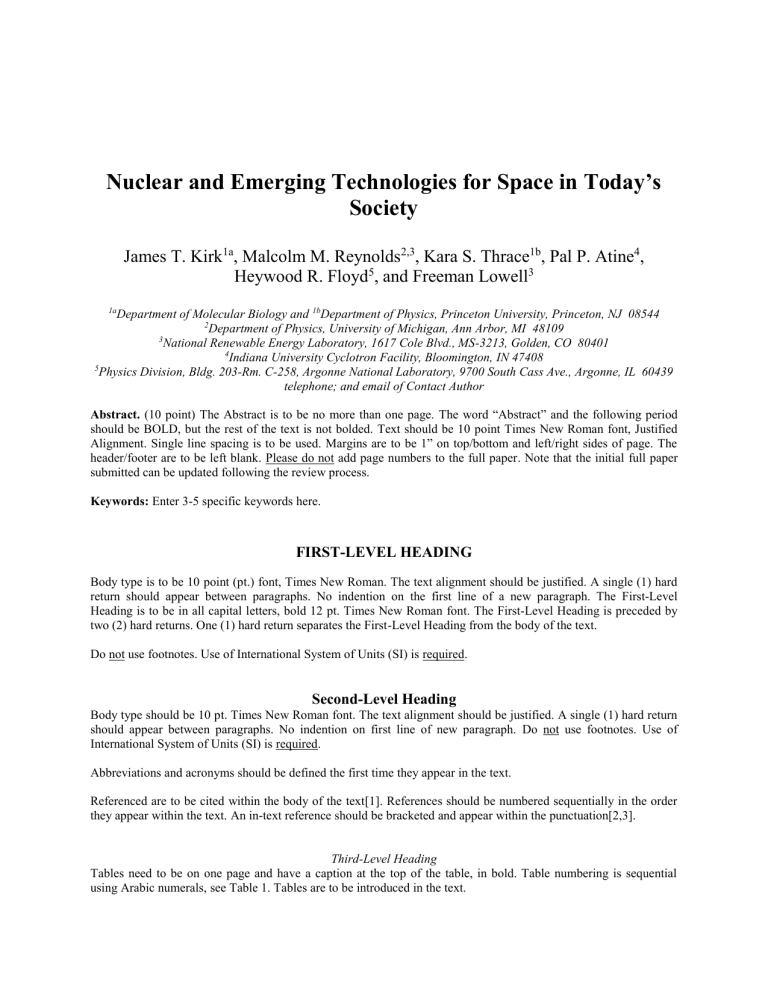
Nuclear and Emerging Technologies for Space in Today’s
Society
James T. Kirk
1a
, Malcolm M. Reynolds
2,3
, Kara S. Thrace
1b
, Pal P. Atine
4
,
Heywood R. Floyd
5
, and Freeman Lowell
3
1a Department of Molecular Biology and 1b Department of Physics, Princeton University, Princeton, NJ 08544
2 Department of Physics, University of Michigan, Ann Arbor, MI 48109
3 National Renewable Energy Laboratory, 1617 Cole Blvd., MS-3213, Golden, CO 80401
4 Indiana University Cyclotron Facility, Bloomington, IN 47408
5 Physics Division, Bldg. 203-Rm. C-258, Argonne National Laboratory, 9700 South Cass Ave., Argonne, IL 60439 telephone; and email of Contact Author
Abstract.
(10 point) The Abstract is to be no more than one page. The word “Abstract” and the following period should be BOLD, but the rest of the text is not bolded. Text should be 10 point Times New Roman font, Justified
Alignment. Single line spacing is to be used. Margins are to be 1” on top/bottom and left/right sides of page. The header/footer are to be left blank. Please do not add page numbers to the full paper. Note that the initial full paper submitted can be updated following the review process.
Keywords: Enter 3-5 specific keywords here.
FIRST-LEVEL HEADING
Body type is to be 10 point (pt.) font, Times New Roman. The text alignment should be justified. A single (1) hard return should appear between paragraphs. No indention on the first line of a new paragraph. The First-Level
Heading is to be in all capital letters, bold 12 pt. Times New Roman font. The First-Level Heading is preceded by two (2) hard returns. One (1) hard return separates the First-Level Heading from the body of the text.
Do not use footnotes. Use of International System of Units (SI) is required.
Second-Level Heading
Body type should be 10 pt. Times New Roman font. The text alignment should be justified. A single (1) hard return should appear between paragraphs. No indention on first line of new paragraph. Do not use footnotes. Use of
International System of Units (SI) is required.
Abbreviations and acronyms should be defined the first time they appear in the text.
Referenced are to be cited within the body of the text[1]. References should be numbered sequentially in the order they appear within the text. An in-text reference should be bracketed and appear within the punctuation[2,3].
Third-Level Heading
Tables need to be on one page and have a caption at the top of the table, in bold. Table numbering is sequential using Arabic numerals, see Table 1. Tables are to be introduced in the text.
Mode of
Transport
USS Excelsior
Dark Star
TABLE 1.
This is an example of a Table Caption and is center aligned with Table.
Time
(s)
Initial Velocity
(m/s)
Acceleration
(m/s 2 )
Final Velocity
(m/s)
Displacement
(10 12 m)
1889.47
2679.02
5.45
9.56
290,059,507
86,314,302
5.481E+11
2.312E+11
517.77
309.75
7.602E+10
42 c
11.70
1.32
Serenity
Valley Forge
307.94
208.90
22.23
0
246,850,478
60,316,966
All equations should be centered and numbered, see Equation (1) and (2). 𝑑 = 𝑣 𝑖 𝑣 𝑓 𝑡 +
= 𝑣 𝑖
1
2 𝑎𝑡 2
+ 𝑎 ∙ 𝑡
(1)
(2)
Figure numbering is to be sequential using Arabic numerals. Figures are to be introduced in the text. Figure 1 gives an example of a table caption that fits entirely on one line.
FIGURE 1.
Captions Should Be 10 pt. Times Roman Font. Center Caption on Page If One Line of Text [4].
Figure 2 gives an example of a figure caption that is longer than one line.
FIGURE 2.
Left Align Captions Longer than One Line of Text, as Shown in this Sample Caption. Remember to
Capitalize All Important Words in Captions. Capitalize and Bold All Letters in “FIGURE #.” Follow the Figure
Number with a Period. Place a Period at the End of Each Sentence/Caption.
CONCLUSION
Please have a conclusions/summary section at the end of your paper. If a nomenclature section is needed, it will follow the conclusions section. All of the “=” in the nomenclature section should be lined up. This can be done by placing tabs before and after the equals sign (=). c = Speed of light, 3×10 8 m/s 𝑑 = Displacement of the object 𝑣 𝑖
= Initial velocity
NOMENCLATURE
𝑣 𝑓
= Final velocity at time t 𝑡 = Time 𝑎 = Acceleration
ACKNOWLEDGMENTS
Please include this section acknowledging any company or government contracts or people who lent their assistance either monetarily or otherwise in the preparation of this work. For consistency in these proceedings, please spell
ACKNOWLEDGMENTS without the “E” between the “G” and “M”.
REFERENCES
[1] Brown, M.P., and Austin, K., The New Physique-Book Name in Italics, Publisher Name, Publisher City, page#page#, (year).
[2] Brown, M.P., and Austin, K., “Title of Paper,” Appl. Phys. Letters-Journal Name in Italics, volume in bold , page#-page#, (year).
[3] Garner, C.E., Layman, W., Gavit, S.A., and Knowles, T., “A Solar Sail Design for a Mission to the Near-
Interstellar Medium,” in proceedings of Space Technology and Applications International Forum (STAIF-
2000) , edited by M. El-Genk, AIP Conference Proceedings 504 , New York, pp. 947-961, (2000).
[4] Finkbeiner, A., “Galazy Formation: The New Milky Way,” Nature , 490 , 24-27, (October 2012), doi:10.1038/490024a.
